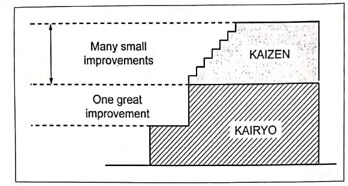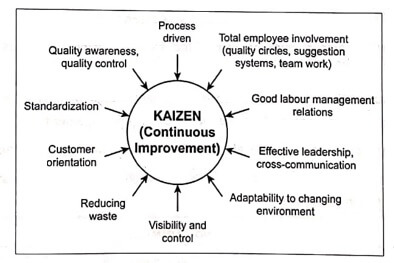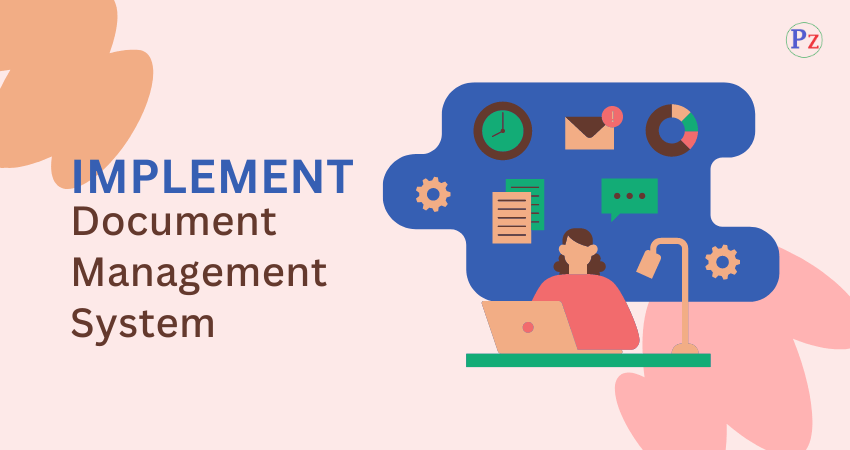Kaizen
What is Kaizen?
✔ Kaizen is a Japanese word which means continuous improvement or improvement over improvement.
✔ It is the process of continuous improvements in small increments that make the process more efficient, effective, controllable, and adequate.
Kaizen Vs Kairyo
✔ Both Kaizen and Kairyo are famous quality improvement approaches.
- In Kaizen (Japanese philosophy), improvement’s are accomplished gradually, i.e., improvements in small increments.
- But Kairyo (Western philosophy) describes improvements through innovation, i.e., improvements in one or two great jumps. Kairyo does not allow constant improvement.

Fig. 1. Comparison between Kaizen and Kairyo
Fig.1. compares the Kaizen and Kairyo.
From Fig.1. it can be seen that Kaizen proceeds slowly, through gradual yet constant changes, whereas Kairyo proceeds in spurts, through major but irregular changes.
The main differences between Kaizen and Kairyo are listed in Table 1.
Table 1. Kaizen Vs Kairyo (Innovation)
| Kaizen | Kairyo (Innovation) | |
| 1. Effect | Long- term and long – lasting, but undramatic | Short- term, but dramatic |
| 2. Pace | Small steps | Big steps |
| 3. Time frame | Continuous and incremental | Intermittent and non- incremental |
| 4. Change | Gradual and constant | Abrupt and volatile |
| 5. Involvement | Everybody | Select few “ champions” |
| 6. Approach | Collectivism , group efforts, systems approach | Rugged individualism, individual ideas one efforts |
| 7.Mode | Maintenance and improvement | Scrap and rebuild |
| 8.Spark | Conventional know-how and state of the art | Technological breakthroughs, new inventions, new theories |
| 9. Practical requirements | Requires little investment, but great effort to maintain it | Requires large investment, but little effort to maintain it |
| 10. Effort orientation | People | Technology |
| 11. Evaluation criteria | Process and efforts for better results | Results for profits |
| 12. Advantage | Works well in slow-growth economy | Better suited to fast-growth economy |
Various Aspects of Kaizen
The various aspects of Kaizen philosophy are shown in Fig.2.

Fig. 2. Various aspects of Kaizen philosophy
Features of Kaizen
According to Glenn Gee et al, the Kaizen improvement focuses on the use of:
- Value-added and non-value-added work activities.
- Muda, which refers to the seven classes of wastes. Wastes are overproduction, delay, transportation, processing, inventory, wasted motion, and defective parts.
- Principles of motion study and the use of cell technology.
- Principles of materials handling and use of one-piece flow.
- Documentation of standard operating procedures.
- The 5S for workplace organisation, which are five Japanese words that mean Proper arrangement (SEIRI), Orderliness (SEITON), Personal cleanliness (SEISO), Standardisation (SEIKETSU) and Discipline (SHITSUKE).
- Visual management by means of visual displays that everyone in the plant can use for better communication.
- Just-in-time principles to produce only the units in the right quantities, at the right time, and with the right resources.
- Poka-Yoke to prevent or detect errors.
- Team dynamics, which include problem solving, communication skills and conflict resolution.
Role of People in Implementing Kaizen
- Top management must be committed to introducing Kaizen as a company strategy.
- The executives just below top management must formulate and carry out Kaizen goals according to guidelines from top management.
- Supervisors, like everyone else, must use Kaizen in their activities.
- Workers must be involved in Kaizen through the suggestions systems and small group activities.




